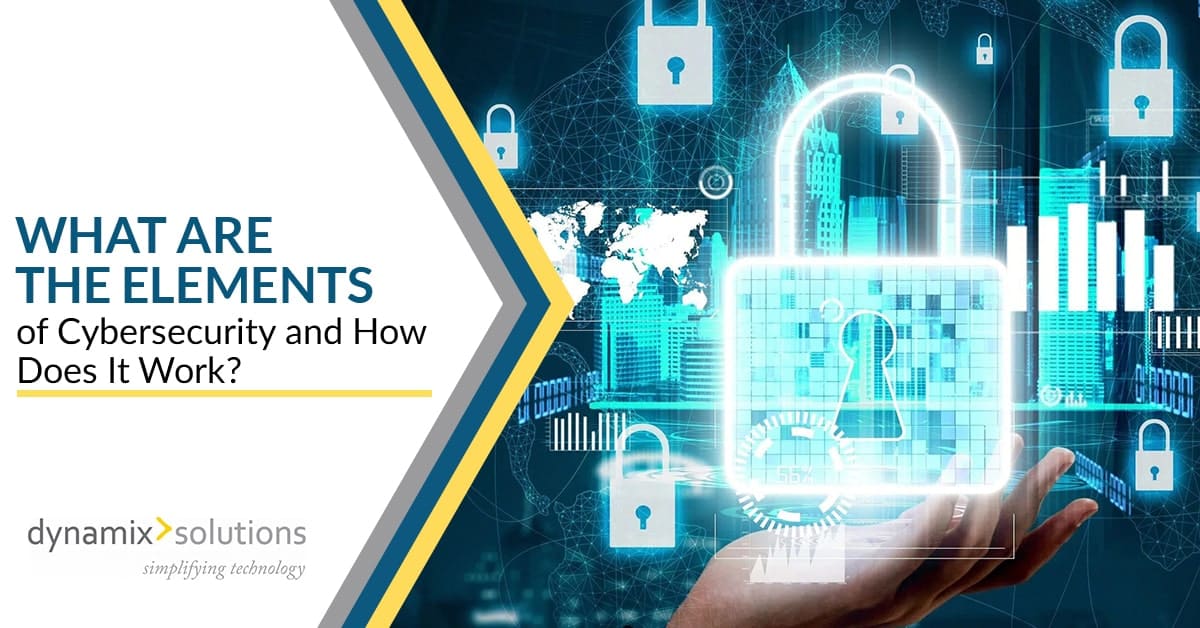What Are the Elements of Cybersecurity, and How Does It Work?
Dynamix Solutions

What Are the Elements of Cybersecurity, and How Does It Work?
The term “cybersecurity” can seem nebulous, as it encompasses so many different things. There is no single tactic that a business can take to secure its technological infrastructure – good cyber security services include multiple layers of protection that address all corners of technology use.
Why is cybersecurity now a vital part of any business operations? The answer is that falling victim to just one cyber attack can leave a business devastated financially. Approximately 60% of small businesses end up closing their doors within 6 months of suffering a data breach or malware infection.
Cyber security companies will look at several areas of a company’s IT infrastructure, from devices to user habits. The goal is to identify areas of risk that could allow a phishing attack to succeed, or enable an attacker to gain access to a company system or cloud application.
Many businesses don’t know where their networks may be vulnerable to attack, since there are so many different methods that hackers can use to get in. A cyber security consultant keeps up with all the latest attack methods, zero-day exploits, and the tools to fight them.
Different Elements of Cybersecurity:
- Application security
- Information security
- Disaster Recovery Planning
- Network Security
- End-user Security
- Operational Security
Each of these elements represents a different area of your infrastructure, and it’s important to protect each one with its own tactics.
Application Security

Application security is all about keeping software applications impervious to threats. While this is a large focus of companies that develop and sell their applications and cloud services, it’s also important for businesses.
Misconfiguration of security settings is a major reason for cloud account data breaches. Companies will use a major cloud service, such as Microsoft 365, but won’t understand that they need to customize their security settings from defaults.
The main causes of cloud application misconfiguration are:
- Lack of awareness of cloud security policies
- Lack of adequate controls & oversight
- Use of too many interfaces to govern
- Negligent insider behaviour (i.e., user error)
Actions such as setting up multi-factor and administration privilege controls are steps that cyber security consulting services will take to help strengthen application security and prevent your apps from being breached.
Information Security

Information security covers the protection of company data and the data that you collect from customers, clients, or vendors.
Most companies will need to adhere to one or more information security standards. These standards can have stiff penalties should negligence result in the compromise of personally identifiable information.
Cyber security companies will look at how you collect, store, and transmit data. They’ll put protections in place to ensure that data is encrypted as needed, and protected from being breached.
Disaster Recovery Planning

Many companies seek out the help of cyber security consulting services when it comes to disaster recovery planning. This is key to keeping your business from being among the 60% that fold after falling victim to a cyberattack.
Disaster recovery protections include two important components:
- Strategies for preventing a breach or malware infection
- Preparations for fast recovery should you fall victim to an attack
Some of the measures that a cyber security consultant will put in place are a backup and recovery system, incident response drills, and strong endpoint protection.
Network Security

Network security involves protecting your physical network and all the devices connected to it. Most companies use firewalls to monitor incoming and outgoing traffic for threats.
Securing your wireless network and ensuring any remote connections happen through encrypted methods are also ways that cyber security services ensure network security.
Network security is designed to ensure that only authorized users gain access to the network, and that no suspicious behaviours are happening inside the network that would indicate a breach.
End-user Security

End-user security is also known as end-point security. This refers to protecting the devices that users work with, and users themselves. End-user security is vital, since 91% of cyberattacks begin with a phishing email.
Some of the most common types of end-user protection that you should have include:
- Keeping devices updated
- Managed Antivirus/anti-malware
- DNS filtering to block malicious websites
- Firmware protection to prevent breaches at the firmware layer
- Passcode-protected screen locks
- Remote management and device detection
If you’re not using end-user security, you could suffer a breach through an unprotected employee device that gets infected with malware and then spreads that infection throughout the company network.
Another important piece of end-user security, beyond device protection, is employee security awareness training. Employees must be trained regularly on how to detect phishing emails, password security, handling sensitive data, and other important cyber hygiene basics.
Operational Security

Operational security involves taking a step back and looking at your entire security strategy as a whole to ensure that all security tactics are working in unison throughout your operations, and that none are in conflict with one another.
When providing operational security consultations, MSPs will try to think like an attacker. They’ll probe all the different areas of your technology environment to see where a potential breach could occur.
Operational security is the umbrella that encompasses all of your IT security processes. It guarantees that the operation as a whole is not only securing all areas of a potential breach, but also regularly updating its security strategies to keep up with the latest threats and security advances.
SCHEDULE A CYBERSECURITY ASSESSMENT TO REVIEW YOUR RISKS
Don’t be in the dark about your cybersecurity risk. Dynamix Solutions can provide a cybersecurity assessment for your Toronto or Calgary business to review any potential areas of risk, and the solutions to address them.
Contact us today to schedule a consultation! Call Toll-Free: 1 (855) 405-1087.
This post What Are the Elements of Cybersecurity, and How Does It Work? first appeared on Dynamix Solutions and was written by James


























